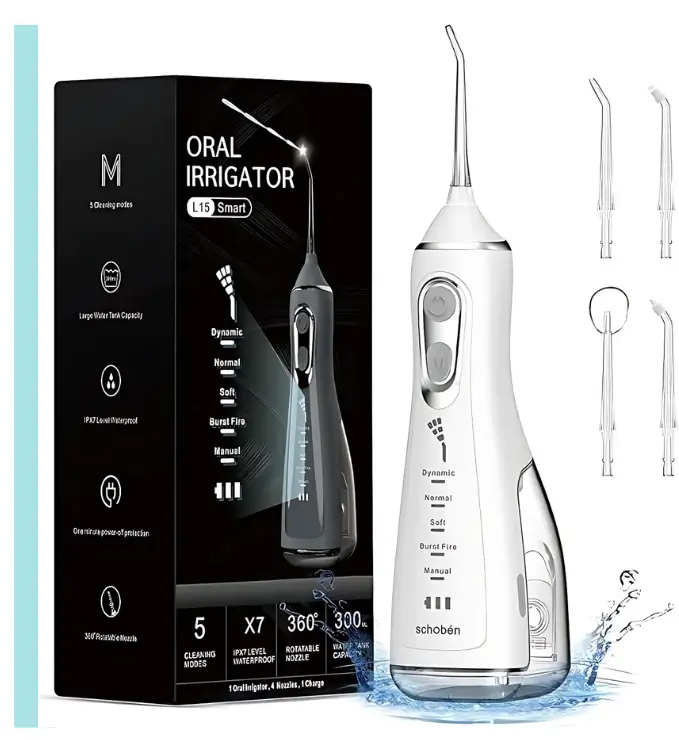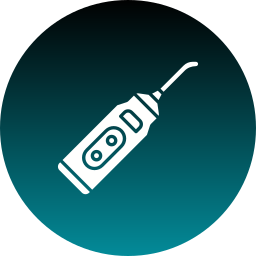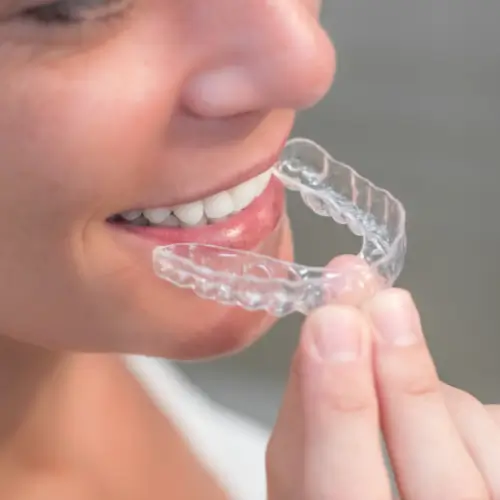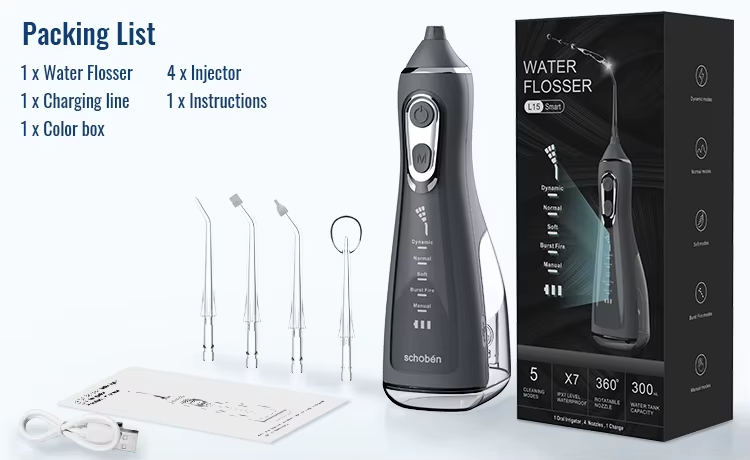Dental Water Flosser
Experience the difference in oral hygiene with the Wellness Plus Schoben Portable Dental Water Flosser.
Enjoy healthier gums, cleaner teeth, and fresher breath, all while applying a more comfortable and efficient oral care routine

Wellness Plus Schoben Portable Dental Water Flosser
Maintaining optimal oral hygiene can be challenging with traditional flossing methods, especially for those with sensitive teeth, braces, or periodontal issues.
Food particles and plaque often accumulate in hard-to-reach areas, leading to gum disease, cavities, and bad breath.
Traditional flossing can be uncomfortable and ineffective for many, resulting in inadequate cleaning and potential long-term dental problems.
Struggling with Oral Hygiene?
Introducing the Wellness Plus Schoben Portable Dental Water Flosser – your ultimate companion for superior oral health! Featuring 5 adjustable pressure settings and a robust 140 PSI for deep cleaning, this flosser caters to every dental need. It’s gentle on sensitive teeth yet powerful enough for those with orthodontics, making it an ideal choice for the entire family.
Why Choose Wellness Plus Schoben Dental Water Flosser?

Comprehensive Cleaning
The 360° rotatable nozzle ensures no spot is missed, providing a thorough clean every time.

Versatile Tips
Includes 4 specialized tips to cater to various dental needs, making it suitable for everyone in the family.

Long-Lasting Battery
Enjoy up to 50 days of use on a single charge. Conveniently rechargeable anywhere, whether it’s at home, on the road, or even in your car.
Features and Benefits
Here are some key features and benefits of the Wellness Plus Schoben Dental Water Flosser:

Portability
Compact and lightweight, making it easy to carry while traveling.

Ease of Use
Simple to operate, often with adjustable pressure settings.

Gentle on Gums
Ideal for individuals with sensitive gums, braces, or dental implants

Improved Oral Hygiene
Effective in reducing plaque and preventing gum disease.

Water Pressure
Uses a stream of pressurized water to clean teeth and gums.

Water Capacity
a convenient 300ml water tank capacity

Rechargeable and Portable
Fully charge in just 3-4 hours for up to 50 days of use. Charge anywhere with portable options like power banks and car chargers, 2200mAh battery capacity.

360° Rotatable Nozzle
Achieve extensive all-round oral cleaning with a fixed/replaceable nozzle.

Pressure Setting for Every Need.
Dynamic 140PSI: Delivers deep
cleaning and gum massage.
Normal 90PSI: Ideal for efficient,
daily cleaning.
Soft 70PSI: Gentle cleaning,
perfect for sensitive teeth.
Burst Fire 65-75PSI: Especially
suitable for orthodontics users.
Manual 60PSI: Customizable
manual pressure according to
personal preference.
4 Tips Included for Diverse Needs
comes with interchangeable tips for different users or specific dental needs.

Standard Nozzle
Daily cleaning, available in customizable colors.

Orthodontic Nozzle:
Removes food debris from braces.

Periodontal Nozzle
Suitable for periodontal pocket cleaning.

Tongue Nozzle
Cleans tongue coating effectively.
Certified Quality
Our product is certified with FCC, CE RoHs IPX7, and ISO9001, ensuring safety and reliability.






Why Brushing Alone is Not Enough
Brushing alone is not sufficient to maintain optimal oral health for several reasons:

Limited Reach
A toothbrush cannot reach the tight spaces between teeth and under the gumline, where plaque and food particles often accumulate.

Incomplete Cleaning
Even with proper brushing techniques, some areas in the mouth remain uncleaned, leading to the build-up of plaque and bacteria.

Orthodontic Appliances
For individuals with braces or other dental appliances, brushing alone is often inadequate in removing debris around the brackets and wires.

Gum Health
Regular toothbrushes may not effectively clean below the gumline, which is crucial for preventing gum disease and maintaining overall gum health.

Sensitive Teeth and Gums
Some people have sensitive teeth and gums that make traditional flossing uncomfortable or painful, leading to neglect of this important aspect of oral care.

By using the Wellness Plus Wellness Plus Schoben Portable Dental Water Flosser, with its convenient 300ml water tank capacity, in conjunction with regular brushing, you can ensure that all areas of your mouth are cleaned effectively without frequent refills.
This combination helps to prevent dental issues, maintain healthy gums, and keep your breath fresh, leading to better overall oral health.
How the Flosser Complements Brushing?
Brushing your teeth with a regular toothbrush is an essential part of maintaining oral hygiene, as it effectively removes plaque and food particles from the surfaces of your teeth.
However, a toothbrush cannot reach all the areas between your teeth and below the gumline.
This is where the Wellness Plus Wellness Plus Schoben Portable Dental Water Flosser comes into play.
The water flosser uses a stream of pressurized water to clean these hard-to-reach areas, ensuring that plaque and food debris are thoroughly removed.
By complementing your brushing routine with a water flosser, you achieve a more comprehensive clean, reducing the risk of cavities and gum disease.

FAQ
A Portable Dental Water Flosser, also known as an oral irrigator, is a dental device designed to clean between teeth and below the gumline with a pressurized water stream. It serves as an alternative or complement to traditional flossing, offering an effective way to remove plaque, food particles, and bacteria from hard-to-reach areas in the mouth.
Incorporating a portable dental water flosser into an oral hygiene routine can greatly benefit those who find traditional flossing challenging or uncomfortable, enhancing overall dental health and cleanliness.
The Wellness Plus Schoben Portable Dental Water Flosser effectively addresses these issues by providing a powerful yet gentle cleaning solution. With adjustable pressure settings and specialized tips, it ensures thorough removal of debris and bacteria from every corner of the mouth. Users benefit from healthier gums, cleaner teeth, and fresher breath, all while enjoying a more comfortable and efficient oral care routine. Regular use of this water flosser can also reduce the risk of dental issues, promoting long-term oral health and hygiene.

We deliver across Lebanon
*We accept cash on delivery and Whish transfer
*Delivery charge of USD 4 may apply
Before using the Wellness Plus Schoben Portable Dental Water Flosser, it is advisable to consult with your dentist or healthcare professional to ensure it is suitable for your specific dental and oral health needs.
